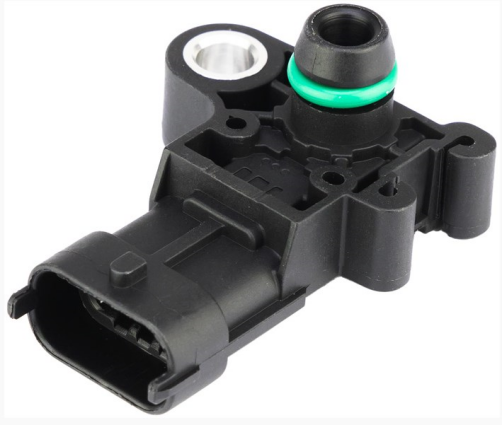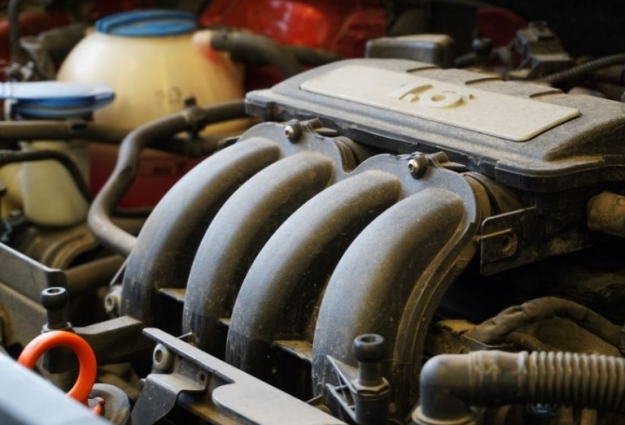A Manifold Pressure Sensor, also known as a MAP (Manifold Absolute Pressure) sensor, is a key component in the engine management system of a vehicle. It measures the pressure within the intake manifold of an engine. This data is crucial for the engine control unit (ECU) to calculate the optimal air-fuel mixture to deliver to the engine for combustion.

The Manifold Pressure Sensor helps the ECU adjust the fuel injection quantity and ignition timing based on the current load and operating conditions of the engine. By monitoring the pressure in the intake manifold, the sensor assists in determining the engine's load, allowing the ECU to adjust various parameters in real-time to optimize performance, fuel efficiency, and emissions.
In summary, the Manifold Pressure Sensor plays a critical role in regulating engine performance by providing essential data to the ECU, helping to ensure the engine operates efficiently under various driving conditions.
What Does the Manifold Pressure Sensor Do
The Manifold Pressure Sensor (MAP sensor) measures the pressure inside the intake manifold of an engine. This information is vital for the engine control unit (ECU) to calculate and adjust the fuel-air mixture and ignition timing, optimizing engine performance, fuel efficiency, and emissions control. Here are some key functions of the Manifold Pressure Sensor:
-
Measure Engine Load: The sensor helps the ECU determine the engine's load by monitoring the pressure in the intake manifold. This information allows the ECU to adjust fuel injection and ignition timing accordingly.
-
Optimize Fuel-Air Mixture: By knowing the manifold pressure, the ECU can calculate the right amount of fuel to inject into the combustion chamber for efficient combustion. This helps optimize fuel economy and engine performance.
-
Control Ignition Timing: The Manifold Pressure Sensor data assists the ECU in adjusting the ignition timing, ensuring that the fuel-air mixture ignites at the correct moment for optimal engine performance and efficiency.
-
Detect Engine Issues: Changes in manifold pressure readings can indicate potential engine problems, such as intake leaks, vacuum leaks, or issues with the EGR system. The sensor helps the ECU detect these issues early, allowing for timely diagnostics and repairs.
-
Improve Emissions Control: By precisely regulating the fuel-air mixture, the Manifold Pressure Sensor contributes to reducing harmful emissions from the vehicle, helping it comply with environmental regulations.
Overall, the Manifold Pressure Sensor is a crucial component in modern engine management systems, providing essential data to the ECU to optimize engine operation, fuel efficiency, and emissions control.

Where is the Manifold Pressure Sensor Located
The location of the Manifold Pressure Sensor (MAP sensor) can vary depending on the engine and vehicle make and model. However, there are some common locations where you can typically find the MAP sensor in most vehicles:
-
On the intake manifold: As the name suggests, the MAP sensor is often located directly on or very close to the intake manifold. It may be mounted on the intake manifold itself or on a nearby vacuum hose or intake tubing.
-
Near the throttle body: In some engines, you can find the MAP sensor mounted near the throttle body, which controls the amount of air entering the engine. It may be positioned on the intake manifold or intake piping leading to the throttle body.
-
Under the engine cover: In some modern vehicles, the MAP sensor may be located under the engine cover, which is located on top of the engine. You may need to remove the engine cover to access and locate the MAP sensor.
-
Near the firewall: Depending on the vehicle's layout, the MAP sensor could be located near the firewall in the engine compartment. This location provides a stable and convenient mounting point for the sensor.
-
Consult the service manual: For specific information on the location of the MAP sensor in your vehicle, it's best to consult the vehicle's service manual or contact a professional mechanic for assistance. They can provide detailed information on the exact location and how to access the sensor for maintenance or replacement.
Overall, the MAP sensor is typically positioned in a location where it can accurately measure the pressure in the intake manifold to provide essential data to the engine control unit for proper engine operation.

Symptoms of Faulty Manifold Pressure Sensor
A faulty or failing Manifold Pressure Sensor (MAP sensor) can lead to various issues with engine performance, fuel efficiency, and emissions control. Here are some common symptoms that may indicate a problem with the MAP sensor:
-
Check Engine Light: One of the most common signs of a faulty MAP sensor is the illumination of the Check Engine Light on the dashboard. The ECU detects discrepancies in the sensor's readings and triggers the light to alert the driver to a potential issue.
-
Loss of Power or Performance: A malfunctioning MAP sensor can cause a decrease in engine performance, leading to a lack of power, hesitation during acceleration, or rough idling. The engine may also struggle to reach higher speeds.
-
Poor Fuel Efficiency: Issues with the MAP sensor can disrupt the engine's fuel-air mixture calculation, resulting in poor fuel efficiency. You may notice a decrease in gas mileage and an increase in fuel consumption.
-
Rough Idle or Stalling: A faulty MAP sensor can cause the engine to idle roughly or even stall when the vehicle is at a stop. Inconsistent or incorrect pressure readings can disrupt the engine's idle control.
-
Hesitation or Surging: The engine may hesitate or surge during acceleration due to incorrect pressure readings from the MAP sensor. This can lead to a jerky or inconsistent driving experience.
-
Black Smoke from Exhaust: A malfunctioning MAP sensor can cause the engine to run excessively rich, leading to the production of black smoke from the exhaust. This indicates an imbalance in the fuel-air mixture.
-
Failed Emissions Test: If the MAP sensor is not functioning correctly, the vehicle may fail emissions tests due to increased emissions output caused by improper engine operation.
-
Difficulty Starting the Engine: In some cases, a faulty MAP sensor may make it difficult to start the engine or cause extended cranking before the engine fires up. This is often due to incorrect fuel delivery.
If you are experiencing any of these symptoms, it is recommended to have your vehicle inspected by a qualified mechanic. They can diagnose the issue, determine if the MAP sensor is faulty, and perform any necessary repairs or replacements to restore proper engine operation.
3 Ways to Easy Addressing Manifold Pressure Sensor Simple Issues
Here are three straightforward methods to address simple issues related to the Manifold Pressure Sensor (MAP sensor):
-
Check and Clean the Sensor:
- Begin by locating the MAP sensor on your vehicle. It is typically located on or near the intake manifold.
- Inspect the sensor for any visible signs of dirt, oil, or debris that may be affecting its performance.
- Use a sensor-safe cleaner to gently clean the sensor and its surrounding area to ensure it is free from any contaminants that could be interfering with its operation.
- Reinstall the sensor and check if the issue persists.
-
Inspect and Repair Vacuum Lines:
- The MAP sensor relies on vacuum pressure in the intake manifold to function correctly. Check the vacuum lines connected to the sensor for any leaks, cracks, or disconnections.
- Replace any damaged vacuum lines and ensure they are securely connected to the sensor and the intake manifold.
- A vacuum leak can cause incorrect readings and impact engine performance. Resolving vacuum line issues can often improve MAP sensor function.
-
Reset the ECU:
- Sometimes, issues with the MAP sensor readings can be due to minor glitches in the engine control unit (ECU).
- To reset the ECU, disconnect the negative terminal of the vehicle's battery and wait for 10-15 minutes before reconnecting it. This process will clear any stored error codes and reset the ECU's adaptive learning.
- Start the vehicle and see if the problem with the MAP sensor persists. Note that you may need to drive the vehicle for some time for the ECU to adapt to the new sensor readings.
These steps are relatively simple and can help address minor issues related to the Manifold Pressure Sensor. If the problem persists after these actions, or if you continue to experience significant issues with the MAP sensor, it is advisable to have a qualified mechanic diagnose and repair the sensor or any underlying issues to ensure the proper functioning of your vehicle.



